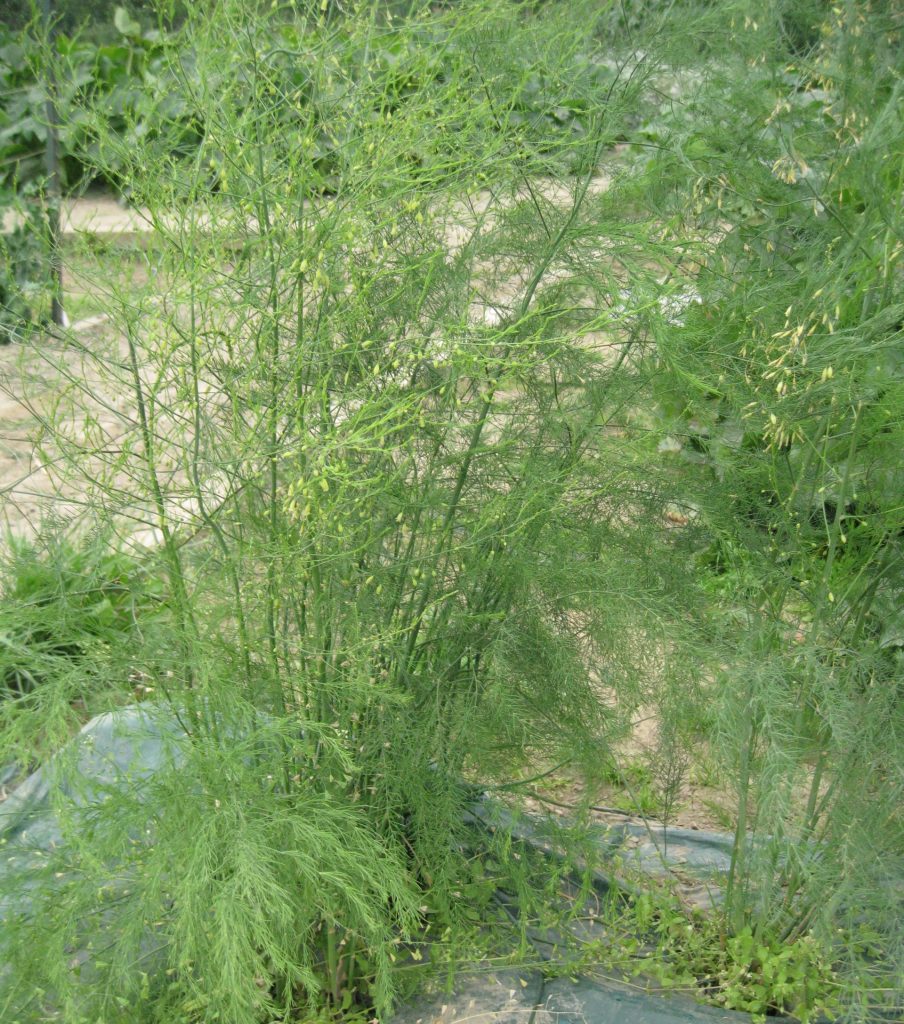Rhubarb patches are common in Alaskans’ backyards, but not asparagus patches. Like rhubarb, asparagus is an edible perennial and, if not quite as reliable or prolific as rhubarb, is certainly one to consider. The beauty of perennials is that once they’re established, they’re relatively easy to maintain and you’ll be harvesting them around the time you’re planting annual vegetable crops. Perennials do require more upfront work than annuals.

Asparagus ferns at the Georgeson Botanical Garden in Fairbanks, Alaska.
In 1995 Pat Holloway described asparagus as “finicky” in Fairbanks and I asked her recently if this was still true. She said yes and explained: “Warmer winters are one thing, but they are like peonies–they need snow cover. We have had spectacular successes on our warm south-facing slopes until we lose the snow then everything is wiped out. If we keep getting these 40 below spells, and there is no snow–not good. At my house–1000 ft elevation, I can’t grow it worth a darn even though I rarely get to minus 25. I get these wimpy stalks that make great feathery fillers, but not much else. They survive, but just barely. I think it is worth trying on the good, warm sites, but don’t be surprised if it doesn’t work.” See what a difference a high tunnel in Homer, Alaska makes in how well asparagus grows in Homer, Alaska.
There have been just a couple asparagus trials done in Alaska that I’m aware of–in the 90’s by Pat Holloway and more recently the Alaska Plant Materials Center starting in 2014. Most of the varieties trialed in the 90s aren’t readily available anymore. Jersey Giant was one of the top performers in these earlier trials and in 2014 so that is probably a good bet. Compared with crowns planted in the same year, Viking KB3, an open pollinated variety, yields were highest. Both Jersey Giant and Viking KB3 are available from Daisy Farms, along with many of the varieties trialed more recently by the Alaska Plant Materials Center.
Rusty Foreaker, Horticulturist with the Plant Materials Center, evaluated survivability of 14 different varieties in 2014 and 2015 in Kenai, Palmer, and North Pole. Notably, hardly any plants survived in Palmer. Rusty blamed this on a complete lack of snow cover or mulch. In Kenai and North Pole, Jersey Gem, Jersey Giant, Sweet Purple, and Del Monte 361 had the greatest survival rates. For further details on these recent asparagus trials including where rootstock was ordered, you can contact Rusty Foreaker at (907) 745-8092 or Rusty.Foreaker@alaska.gov.
You can plant asparagus from bare-root crowns, from seed, or from a potted plant. Planting from crowns gives a one year head start on planting from seed. However, there can be quite a bit of variability in the quality of root crowns and planting from seed ensures that you’re not importing any pests or diseases. Starting potted asparagus is the most expensive option but the quickest route to eating your homegrown asparagus. Minnesota Extension recommends planting your asparagus about 6-8 inches deep in a well-tilled trench. At first, cover the crowns with just 2 or 3 inches of soil. As the asparagus grows, gradually fill in the trench. Plants should be spaced about 15 inches apart in a 25-inch wide bed. If you’re lucky, the ferns will grow high–up to 5 or 6 feet!
As with most vegetables, asparagus prefers a slightly acidic to neutral pH (6.5-7.0). Before planting, fertilize according to a soil test either conventionally or organically. In years two and three, fertilize or add compost early in the spring before the spears develop and afterwards. Subsequent you can fertilize once a year as it appears they need it.
Growing asparagus requires some patience and restraint. Don’t be too eager to harvest the first spears–wait until the plants are three years old–and even then, don’t harvest all of the spears. Harvest only the larger spears (about 6-8 inches long) and leave the rest to develop into ferns as this will help the roots grow and the plant to be more productive in subsequent years. You can remove the ferns in the spring after they have died back. Ideally, your plants will be productive for about 15 years.
You can find more in depth growing instructions from Minnesota Extension. Although conditions in Alaska are obviously different, we do share a cold climate.
Previously published in the Fairbanks Daily Newsminer July 1, 2018.